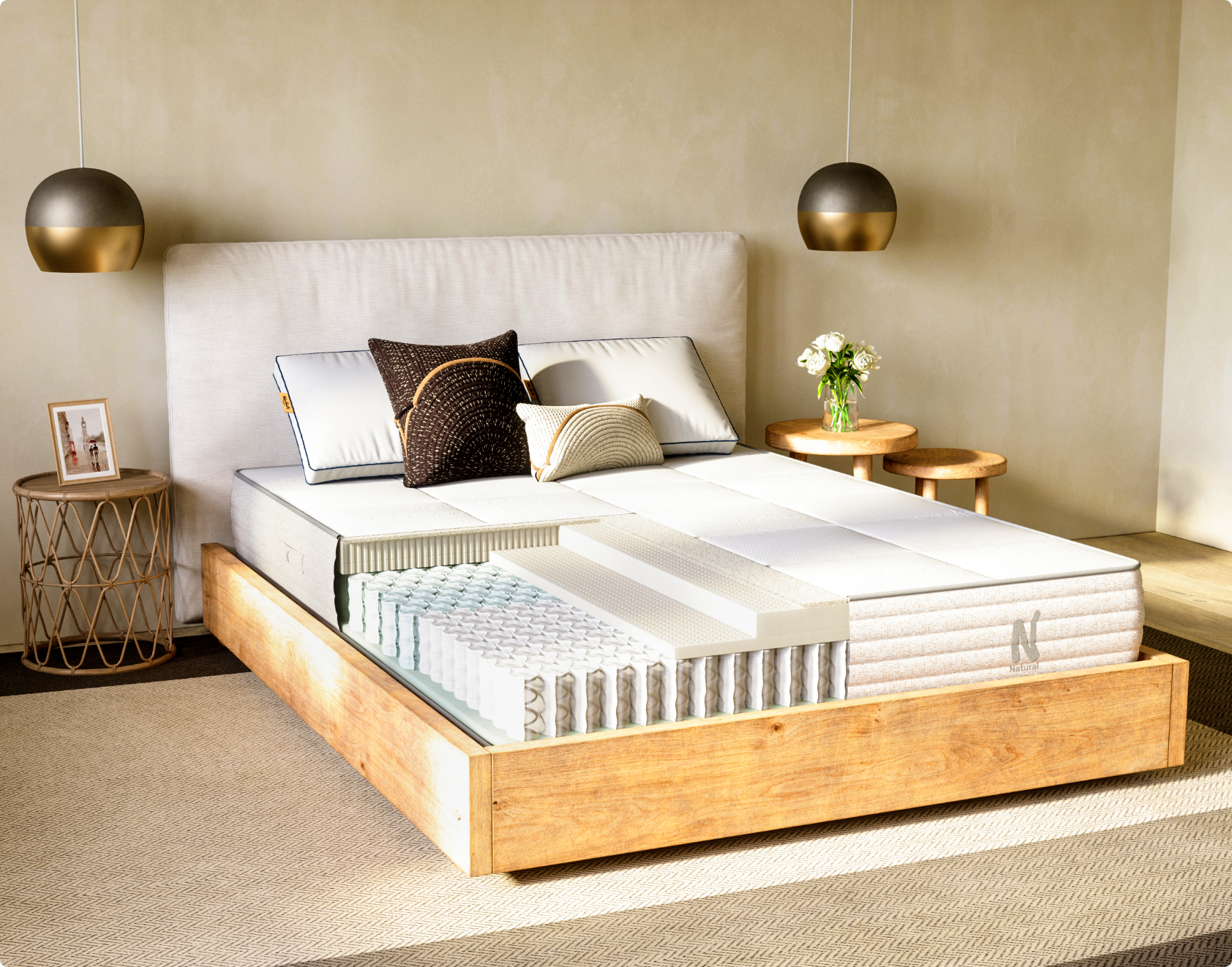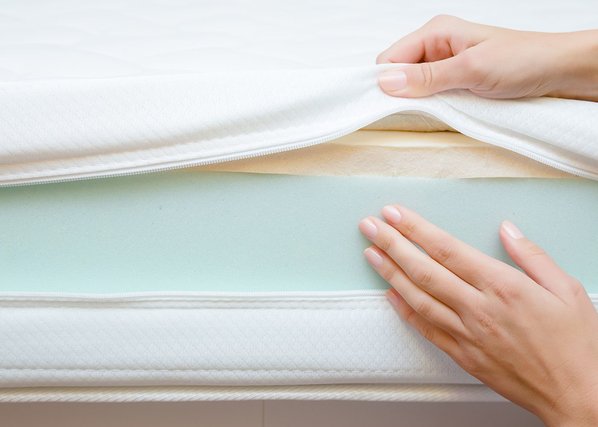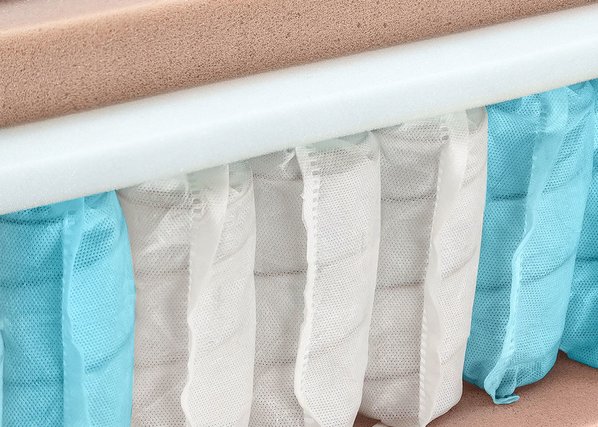
Mattress Material Guide
Which Mattress Type Is Right for Me?
Introduction to Mattress Types and Materials
When shopping for a new bed, choosing which type of mattress you want is a critical decision.
Every mattress brand has its own technology and manufacturing methods, and each model has unique features. However, mattresses of the same type share common qualities, regardless of their origin.
What does “type” mean in the mattress market? It generally refers to a combination of two factors: a mattress’s construction and its primary material.
This guide will walk you through the most common mattress types: foam, latex, hybrid, innerspring, and the latest in mattress technology—adjustable airbeds. We’ll go over how each mattress type is made, their advantages and advantages, and which sleeper profiles best fit each option. You can also check out this Wired guide to the Best Mattresses You Can Buy Online, featuring a wide variety of mattress types.
Mattress Terms All Shoppers Should Know
Before diving into the mattress shopping process, take a minute to review key mattress terminology. These terms and concepts will help you analyze each mattress type and find what works best for you.
Support: How well a mattress holds the body in place and keeps the spine aligned.
Pressure Relief: A mattress’s ability to distribute a sleeper’s weight evenly, reducing pressure at peak pressure points like the shoulders, back, and hips.
Firmness Level: How soft or firm a mattress feels. Firmness level is measured on a scale from 1 to 10, with 10 being the firmest. We explore this concept at length in our Mattress Firmness Guide.
Contouring: The way a mattress material molds to your body, hugging your curves.
Responsiveness: How quickly a mattress reacts to pressure and pressure removal.
Motion Isolation: A mattress’s ability to contain the motion when you add or remove pressure.
Cooling: How quickly and effectively a mattress dissipates heat.
Breathability: How much ventilation or air circulation a mattress material allows.
Edge Support: How well the perimeter of a mattress resists sinking and supports your weight.
Durability: How well a mattress resists sagging and natural wear and tear.
Lifespan: How long a mattress lasts without sagging and losing structure or support.
Foam Mattresses
Introduced in the 1950s, foam mattresses now rival innerspring mattresses in popularity. Foam mattresses make up the fastest-growing sector of the mattress market, projected to value $42.77 billion by 2027.
What makes foam mattresses so sought-after? Unlike pre-dating mattress materials, foam hugs your body and responds to your movements. This flexibility gives mattress foam two key features: contouring and responsiveness.
However, shoppers should know that not all foam mattresses are made the same way or with the same ingredients. There’s a lot of diversity within this mattress category, with foams ranging in density, chemical composition, construction, firmness, temperature-regulating capabilities, and more. At Nolah, our foam mattresses feature our breathable, pressure-relieving, and deeply supportive AirFoam™ technology for maximum comfort and durability.

Latex Mattresses
Latex mattresses have been around since the 1930s but have recently surged in popularity as more and more consumers and brands commit to eco-conscious products. You may come across synthetic latex mattresses, but this guide focuses on natural latex foam made with latex sustainably tapped from rubber trees.
Features and Qualities
Support
Stronger than memory foam and most polyfoam, latex foam offers superior support and spinal alignment. This high-resilience material cushions your curves and joints but doesn’t sink too far, even for stomach sleepers and heavier individuals.

Pressure Relief
Latex foam provides exceptional pressure relief. Thanks to its responsive nature and open-cell structure, latex redistributes your weight and reduces peak pressure around sensitive joints.
Firmness Level
People often associate latex with firmer beds, but latex comes in a range of firmness levels like other mattress foams. Instead of density, manufacturers use impression load deflection (ILD) to represent latex firmness. Shoppers can use the chart below as an approximate guide to latex ILD and mattress feel.
ILD
Feel
14
Super Plush
19
Plush
24
Soft
28
Medium
32
Firm
36-44
Extra Firm
Contouring and Responsiveness
Like Nolah AirFoam™, latex foam offers gentle contouring rather than deep conforming. It responds to your movements and contours to your curves but won’t sink or make you feel stuck in the foam.
Latex’s responsiveness sets it apart from all other mattress foams. It instantaneously reacts to pressure and pressure removal, giving it its bouncy quality. This attribute makes latex a perfect fit for combination sleepers and people who tend to toss and turn in their sleep. When you shift positions or readjust your body, the mattress immediately responds and contours to your new positioning.
Motion Isolation
Due to latex’s natural bounce, it doesn’t contain motion quite as well as AirFoam™, memory foam, and other polyfoams. However, its motion isolation is still far superior to traditional innerspring mattresses, and the average sleeper won’t have any issues.
Cooling and Breathability
Hot sleepers will appreciate the breathability and temperature-neutral composition of latex mattresses. Natural latex foam contains zero harsh, heat-trapping chemicals, and its porous structure lets air flow in and out, keeping the material cool all night. Many latex models also feature natural cotton covers and wool components, which increase cooling.
Edge Support
Thanks to its natural strength and resilience, latex provides better edge support than most other mattress foams. As with other foam materials, sleepers who want extra edge support should look for models with a reinforced perimeter or may prefer a latex hybrid option.
Durability and Lifespan
In addition to its sustainable sourcing, natural latex’s longevity makes it a highly sustainable material. A latex bed can last more than 20 years if taken care of properly. That said, you should replace your mattress sooner than that for sanitary reasons. Even if you use a mattress protector, you shouldn’t use the mattress for more than 15 years, give or take.
When it comes to latex mattresses, your bed will maintain its firmness and support throughout its lifespan.
Additional Benefits
As a natural material, latex has a few other notable qualities that prospective shoppers should know about. If you’re looking to lower your carbon footprint, you’ll be happy to hear that latex foam is biodegradable and many latex mattresses are organic. Natural latex is also a hypoallergenic material ideal for sleepers with allergies or asthma.
Who Should Buy a Latex Mattress?
Side, Back, Stomach, and Combo Sleepers– Natural latex is a highly versatile material, making it a great fit for many sleeper profiles. A person’s ideal mattress also depends on their weight, but there are latex models suitable for all sleep positions.
Eco-Conscious Shoppers– Sustainably sourced, durable, and biodegradable, latex is an eco-friendly material perfect for mattress shoppers who want to reduce their carbon footprint or maintain a clean, eco-conscious home.
Parents with Growing Kids– Latex mattresses are highly versatile, resist wear and tear, and are naturally hypoallergenic, making them perfect for growing children and teens.
Hybrid Mattresses
Hybrid mattresses combine a coil support layer with numerous comfort layers on top. The hybrid design gives these premium mattresses the heavy-duty support and stability of an innerspring mattress and the contouring, pressure-relieving qualities of a foam or latex bed. Thicker and a bit pricier than other mattress models, hybrid mattresses typically pack in the latest mattress technology and luxury features.
Most hybrids use individually-wrapped coils, the latest iteration of spring support systems. The top comfort layers usually consist of memory foam, polyfoam, or latex foam. In this guide, we’ll focus on the benefits of latex hybrids (like the Nolah Natural) and our AirFoam™ hybrids.

Features and Qualities
Support
The strongest, most supportive mattresses are typically hybrid models, which benefit from multiple layers of supportive foam and a system of tensioned springs. Many hybrid mattresses, like Nolah’s, feature zoned coils for targeted support in high-pressure areas.
Pressure Relief and Contouring
For hybrid mattresses, these qualities primarily derive from the comfort layers. They take on both the advantages and disadvantages of the material used for the uppermost layers—typically memory foam, another polyfoam, or latex foam.
Firmness Level
Hybrid mattresses come in a wide range of firmness levels, suiting sleepers of all sizes, sleep positions, and comfort preferences. Nolah currently offers six hybrid mattress models with the following firmness level ratings.
Nolah Nurture (Flippable): 4-5 and 6-7
Nolah Evolution (3 Firmness Level Options): 4-5, 6-7, or 7-8
Nolah Evolution Comfort+: 5-6
Nolah Natural: 6
Nolah Original Hybrid: 6
Nolah Signature Hybrid: 6
Responsiveness and Motion Isolation
As previously mentioned, most hybrids use individually-wrapped coils, meaning they stand independently of one another and come wrapped in their own fabric sleeves. When paired with a responsive comfort layer material, like AirFoam™ or latex, individually-wrapped coil systems move with your body and readjust when you switch positions. Individually-wrapped coils also give hybrid mattresses increased motion isolation.
Cooling and Breathability
Once again, a hybrid mattress’s cooling properties largely depend on the material used for the comfort layers. Hybrid beds also benefit from the open structure of their coil support layers. Plus, many individually-wrapped coil hybrids use cotton or other breathable materials for the coil sleeves.
Edge Support
Compared to all-foam and all-latex models, hybrid mattresses tend to have superior edge support. Many hybrids, like the Nolah Evolution, feature reinforced edges using stronger coils around the bed’s perimeter.
Durability and Lifespan
Thanks to their robust design, hybrid mattresses have high durability and a long lifespan. With proper care, a hybrid mattress can last up to 15 years, depending on the comfort layers’ material.
Hybrids with reinforced edge support and stability base layers tend to last the longest. For example, the coils in all Nolah hybrids are individually wrapped and rest on a foundation layer for maximum stability and strength.
Who Should Buy a Hybrid Mattress?
Side, Back, Stomach, and Combo Sleepers– Hybrid mattresses come in a range of firmness levels, but all offer heavy-duty core support. Regardless of your preferred sleep position, you can find a hybrid model that suits your comfort and support needs.
Sleepers with Back Pain– Hybrid models combine contouring, pressure-relieving foam with hefty, tensioned coils. They offer both cushioning and stability, relieving pain around high-stress areas. Many modern hybrids also feature zoned coils, providing targeted support in the lumbar area.
Heavier Sleepers– The thick, multi-layer design of hybrid mattresses make them sturdy and supportive, providing the stability and firmness that heavier sleepers need for proper spinal alignment.
Innerspring (Coil) Mattresses
Innerspring mattresses, also known as coil mattresses, date all the way back to the 1870s and remain the most common type of mattress. Coil mattresses widely range in quality, with many budget models available. However, since the advent of hybrid mattresses, few mattress brands make high-end innerspring beds, focusing instead on their newer, more advanced counterparts.
What’s the difference between a hybrid and a traditional spring mattress? While hybrids feature numerous comfort layers, innerspring mattresses typically only have a single, thinner layer. This layer typically consists of memory foam or a pillow top filled with cotton, polyester, or a blend of the two.

Features and Qualities
Support and Firmness Level
In general, coil mattresses provide ample resistance and stability, keeping your spine stabilized and aligned. The type of coils, coil count, gauge (thickness), and tension all contribute to an innerspring mattress’s supportiveness and firmness level. In general, spring mattresses with individually-wrapped coils, a higher coil count, a lower gauge, and tighter tensioning offer more resistance. But shoppers must look at all of these factors collectively to assess a spring mattress’s feel, support level, and durability.
Pressure Relief and Contouring
Because innerspring mattresses have only one comfort layer, they offer limited pressure relief and contouring compared to all-foam, all-latex, and hybrid models. If you want the support of a spring mattress but struggle with pain around pressure points and joints, you’ll likely prefer a hybrid option.
Responsiveness and Motion Isolation
Higher-end innerspring mattresses use the same individually-wrapped coil design as hybrids, but most models still use the traditional continuous coil construction.
On a mattress with interconnected springs, movement transfers across the bed, meaning your partner may feel a disturbance when you shift positions. This design also limits responsiveness, as the entire spring system moves together when you adjust your body.
Cooling and Breathability
By nature, innerspring beds have an open structure, allowing air to flow freely through the coil support layer.
Edge Support
As with hybrid mattresses, some innerspring models have reinforced edges with stronger, thicker coils. Be sure to look for this feature if you have trouble getting in and out of bed and sit on the mattress edge to make this transition easier.
Durability and Lifespan
As previously mentioned, an innerspring mattress’s durability depends on the quality of the coils, including their type, count, gauge, and tension. They typically last from seven to 10 years, though newer models with individually-wrapped coils may last longer.
Who Should Buy an Innerspring Mattress?
Stomach Sleepers– While innerspring mattresses don’t offer the cushioning and contouring that side and back sleepers need, some stomach sleepers prefer their firm feel. If you’re a stomach sleeper who doesn’t have the budget for a latex or hybrid model, an innerspring mattress is your next best option.
Heavier Sleepers– As with stomach sleepers, heavier individuals typically prioritize support over contouring and cushioning. Again, innerspring mattresses make a good fit for those who like a firm bed but want to keep costs low.
Adjustable Airbeds
When you hear the word “airbed,” you may think of the inexpensive, inflatable mattresses you keep in the back of the closet for the occasional guest or camping trip. However, the term has taken on a whole new meaning in the mattress industry since the release of luxury mattresses with adjustable air chambers.
Like hybrid mattresses, airbeds combine a support core with upper comfort layers made from memory foam, polyfoam, latex, or other various mattress materials.
But instead of using coils for their primary support layer, airbeds use a series of air chambers, most commonly made with vulcanized rubber. The number of air chambers packed within the mattress varies between models and makers, but currently, most have two to eight independently-adjustable sections.
Features and Qualities
Support and Firmness Level
What makes airbeds so luxurious? Their adjustability.
Sleepers can control the inflation of each individual air chamber, letting you customize the firmness and support level of each region of the bed. You can independently adjust the section of the mattress that sits beneath specific pressure points and joints, depending on how many air chambers the mattress contains and where they’re placed.
The adjustable air chambers also let you and your partner find the settings that work best for you, keeping your spine perfectly aligned. An airbed’s adjustable design also makes it suitable for sleepers of all body types and sleep positions.
Pressure Relief and Contouring
As with hybrid beds, the level of countering and pressure relief an airbed provides depends on the material used for the top comfort layers. Before deciding on a specific airbed model, shoppers should compare the advantages and disadvantages of memory foam, polyfoam, and latex foam and identify which works best for their needs.
Responsiveness and Motion Isolation
Thanks to their independent air chambers, airbeds offer excellent responsiveness and motion isolation. They work great for couples, letting each partner move around freely and adjust their side of the bed without disturbing the other sleeper.
Cooling and Breathability
How hot or cool an airbed feels primarily depends on the comfort layers. Hot sleepers should look for an option with a temperature-neutral material, such as natural latex.
Edge Support
Most airbeds do not have additional reinforcement around the edges. The adjustable air chamber is run from head to foot, not from side to side, so you can’t independently control the firmness of the side edges.
Durability and Lifespan
These premium mattresses feature many high-tech components, making them susceptible to malfunction and damage. However, most airbeds have a modular design, meaning you can replace a faulty part without affecting the rest of the mattress. For example, most airbeds feature removable air pumps.
Additional Benefits
Many airbeds also include state-of-the-art smart bed features, like automatic adjustments and sleep tracking through motion and weight distribution sensors. Otherwise, you can adjust the mattress using a smartphone app.
Who Should Buy an Adjustable Airbed?
Couples with Different Sleep Positions and Body Types– Adjustable airbeds allow complete customization on both sides of the mattress, meaning you and your partner can choose unique settings. You can also adjust your side of the bed throughout the night without disturbing the other sleeper.
Shoppers with a Flexible Budget– Airbeds typically use state-of-the-art smart technology and the highest quality materials possible, making them significantly more expensive than other beds. But if you have the means for a deluxe mattress, buying an airbed—and an adjustable base—is the best way to customize your sleep setup.
What’s Next?
By this point, you’re a mattress material expert! You’re likely ready to select the mattress type that fits you best. But if not, don’t worry—you can always chat with one of our knowledgeable customer support team members for more information or advice.
Once you’ve decided on a mattress type, you’re one step closer to finding your perfect mattress. You can now continue onto the next step of our Mattress Buying Guide: identifying your ideal mattress firmness level. You can learn all about mattress firmness and how to find your fit here.
Frequently Asked Questions
Need help from a Nolah expert? Start a Live Chat below.
Disclaimer: Nolah does not provide medical advice. All resources on the Nolah blog, including this article, are informational only and do not replace professional medical counsel. Talk to your doctor about any health, mental health, or sleep-related issues.